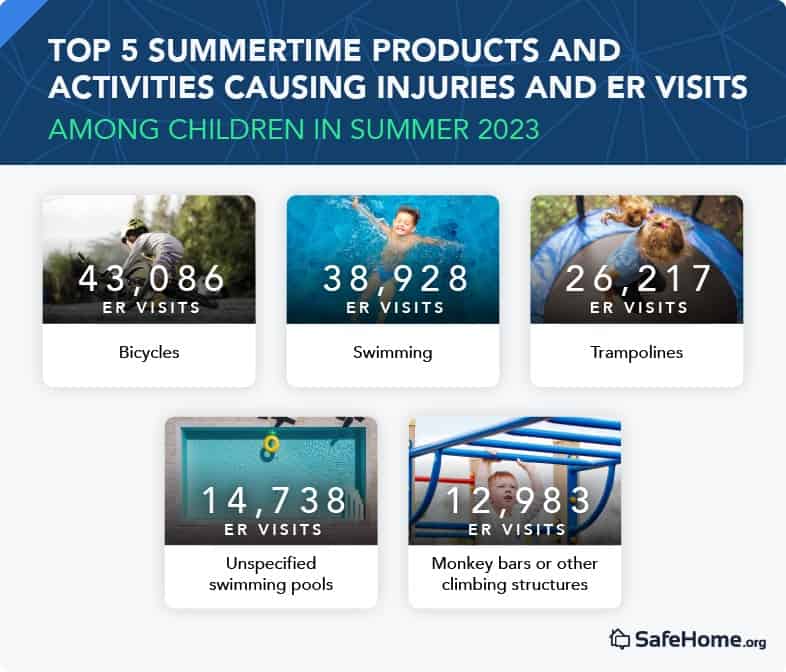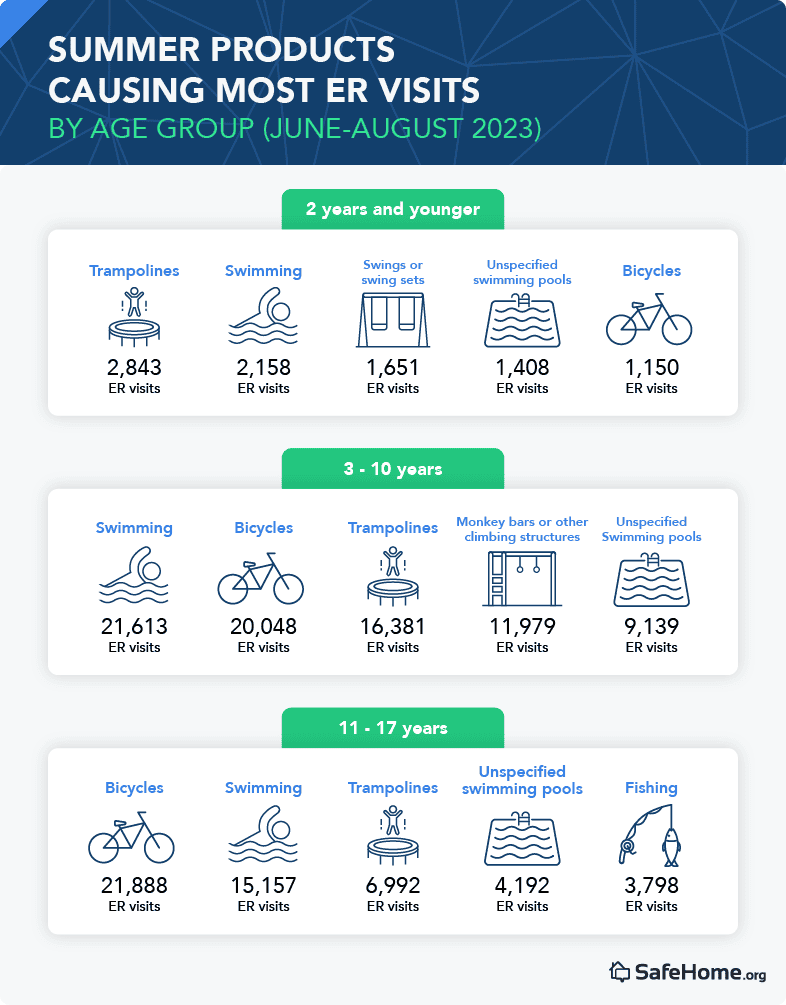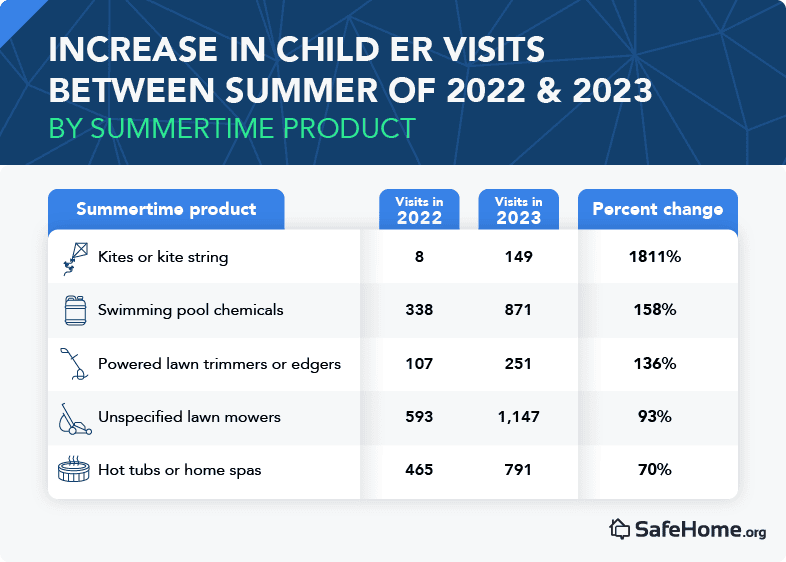Preventing Summer
ER Trips: Children's Injury Trends
and Statistics 2024
Summer should be all about fun in the sun, but last summer alone, nearly 200,000 children suffered injuries that sent them to local emergency rooms (ER). These injuries were caused by products we love to enjoy in the summertime, like pools, bikes, fishing tools, and playground equipment.
We analyzed the latest data from the U.S. Consumer Product Safety Commission’s National Electronic Injury Surveillance System (NEISS) to reveal what summer activities can be riskiest for kids. We hope this new information helps you understand the products and activities most commonly responsible for children's ER visits and simple tips to keep your kids safe all summer.
Key Findings
- Between June and August 2023, nearly 200,000 children suffered injuries from summertime activities and items like pools, grills, camping equipment, and fishing poles.
- Last summer, the five summertime items most likely to send children to the ER were bikes, swimming equipment and pools, trampolines, and playground climbing equipment like monkey bars.
- Between the summers of 2022 and 2023, children’s injuries from swimming pool chemicals, lawn trimmers, lawn mowers, hot tubs, and even kites increased dramatically.
- Though children are particularly vulnerable to pool-related injuries, adults made up 37% of all ER visitors injured in or around pools last summer.
Summer Products Most Likely to Injure Children
Last summer, nearly a million children went to ERs between June and August due to injuries from summertime products. Children accounted for 29 percent of all ER visits between June and August.
We defined “summertime products” as items often used during the summer months in and around the home, such as grills, fireworks, lawn care equipment, water toys, lawn games, and fixed installations like decks, pools, and patios. While these products can pose a risk to adults, they are particularly hazardous for children, who may not be aware of their potential dangers.
Summer presents a perfect opportunity for children to take advantage of outdoor play. Still, parents and caregivers need to remain vigilant of the potential dangers that accompany the season. Our analysis of ER visits between June and August 2023 highlights the top five summertime products that caused the most injuries for children.
Overall, swimming/pools, bikes, trampolines, and monkey bars were the primary culprits behind emergency room visits for children in the summers of both 2022 and 2023. These activities and products are popular among kids during the warmer months, providing ample opportunities for accidents.
A combination of factors, such as lack of supervision, insufficient safety measures, and children's natural inclination to test their limits, contributes to the increased risk of injury from these items.
Parents can help their children avoid unnecessary injuries during the summer months by paying close attention to these common hazards. Teaching kids how to use these products safely and responsibly is crucial, as is providing them with the necessary safety gear and guidance. Of course, kids in different age groups will have slightly different risks, which we’ll explore next.
Age-Specific Risks for Children During Summer
The table below illustrates the most common summertime products that cause injuries among children in different age groups: toddlers aged two years or younger, kids aged three to 10 years, and preteens and teens 11-17 years old. By examining these differences, we can better understand the risks for each group and provide parents with targeted prevention strategies.
Two years or younger
Trampolines are the leading cause of injuries in this age group, which is quite different from the older age groups, where swimming and bicycles are top hazards. Swings and swing sets are more dangerous for this age group than the other groups since these little ones may not have the balance and coordination to use them as safely as older kids can. To prevent accidents among this vulnerable group, parents can:
- Keep young children under age six off of trampolines. The American Academy of Pediatrics recommends not purchasing trampolines for home use at all.
- Use specially designed toddler swings with leg openings, which are more secure than regular swings. Children under a year old shouldn’t use any type of playground equipment.
- Keep toddlers away from pools and other water without close supervision. Accidents can happen quickly. This may mean installing smart locks or safety gates if you live or vacation near a pool, lake, or ocean.
>> Also see: Childproofing Report
Three to 10 years old
Swimming and bicycles dominate the list of hazards for this age group, indicating that these activities become more popular and potentially more dangerous as children get older and more active. Monkey bars or other playground climbing apparatus are major hazards for children aged three to 10, while they are not on the list for the youngest age group or teenagers.
To keep this age group safe, parents should:
- Provide swimming lessons and enforce strict water safety rules, such as not diving in shallow areas or running near the pool edge.
- Encourage using helmets and other protective gear while riding bicycles, and teach children about traffic safety while riding their bikes.
- Supervise playtime on trampolines and playground equipment, promoting safe behavior and age-appropriate use. Keep children under six off of trampolines.
11-17 years old
Unlike the younger age groups, fishing was a top hazard for tweens and teens aged 11-17. This indicates that children may encounter different risks as they age and explore new activities. Biking and swimming pools remain consistent hazards across all age groups, but the risks may differ depending on the child's age and the activities they engage in around the pool. To help prevent accidents among this age group, parents can:
- Reinforce the importance of wearing helmets and adhering to traffic safety rules while biking.
- Encourage responsible behavior around water, including swimming with a buddy and avoiding risky activities like diving in unknown waters.
- Discuss safe fishing practices, such as how to carefully handle knives and fishing hooks and boating and water safety.
Products with the Biggest Increases in Children’s Injuries in 2023
Generally, there was a five percent decrease in child summertime ER visits between the summers of 2022 and 2023. While this is welcome news, some products had significant increases in the number of injuries they caused year over year, including kites, pool chemicals, lawnmowers, and trimmers.
Let's explore why these products are likely to cause injuries and examine some real-life accounts from the data that illustrate how children get injured by these products.
Kites and kite strings
Though seemingly harmless, kites can sometimes cause injuries when children play without proper caution. Several accounts in the NEISS database revealed that children injured themselves by running and falling into trees or fences while flying their kites. Remind children to pay attention to their surroundings while flying kites and to stop and stand in place if they want to admire their kites in the sky.
Swimming pool chemicals
Swimming pool chemical injuries rose dramatically among children last summer. If inhaled, they can cause burns, skin irritation, or even breathing problems. For example, last summer, a 13-year-old girl was injured while putting chemicals into the family pool. The wind blew them back into her face, and she accidentally inhaled some. If you have teens who help maintain the pool, teaching them how to treat the water with chlorine or other chemicals safely is important.
Lawn trimmers or lawn mowers
Mowing lawns is a typical summer chore for many older kids and teens in the U.S. However, they can be dangerous due to their sharp blades and potential for projectile debris if not used or appropriately supervised. While lawnmowers and trimmers are unsafe for little ones, the NEISS database was filled with stories of injuries to teens helping in their yards. For example, a 17-year-old slipped while operating a push lawn mower and caught his foot beneath the blade, which fractured and lacerated the toe. Other teens were burned or hit with projectiles while cutting grass.
While these injuries are alarming, parents can help teens reduce risk by providing thorough instruction on proper usage, emphasizing the importance of safety gear like goggles or gloves, and supervising them until they demonstrate competence.
Hot tubs and home spas
First and foremost, like pools, hot tubs present a drowning risk to children. Sadly, at least one child under the age of two drowned in a home spa last year. These types of tragic injuries and milder injuries can be prevented. According to the database we examined, several children and teens slipped while exiting hot tubs or were injured while closing the lids. Others presented to emergency rooms with rashes from chemicals in the water. Hot tub lids should be closed and secured when not in use to prevent kids from getting in without supervision. To reduce slips, install non-slip mats surrounding the spa, remind kids to pay attention, and be cautious when climbing in or out.
Pool Safety Tips for Children
While pools provide hours of enjoyment, it's essential to remember that they can also present risks to children. In the summer of 2023, more than 61,000 children in the U.S. visited emergency rooms due to swimming or pool related injuries.
Parents and caregivers must remember that pool time also comes with potential hazards. To help ensure a fun and safe swimming experience for your children, we've compiled a list of pool safety tips based on the pool products most likely to cause injuries. The tips are arranged in descending order, starting with the products that caused the most injuries in the summer of 2023.
Swimming (activity, apparel, or equipment) –38,928 injuries:
When it comes to swimming, ensuring your children have age-appropriate swimming lessons is essential. Encourage them to swim with a buddy or under adult supervision, and provide life jackets or flotation devices as needed. It's also crucial to teach children about potential hazards, such as swimming in areas with strong currents or sudden drop-offs. Establish rules with your children before you take them swimming, and enroll them in swimming lessons if possible.
Built-in swimming pools – 3,556 injuries:
Regular inspection and maintenance of built-in swimming pools and their surroundings are necessary to ensure safety. Using slip-resistant materials for the pool deck can minimize the risk of falls, and clearly marking pool depths can prevent diving-related injuries. Creating a physical barrier, such as a pool fence, can also help prevent accidental access to the pool area.
Diving or diving boards – 1,133 injuries:
Teaching children proper diving techniques and allowing diving only in deep water can help reduce the risk of injuries related to diving or diving boards. Ensure diving boards are correctly installed, maintained, and used according to manufacturer guidelines. Consider removing diving boards if they pose a significant risk to children's safety.
Swimming pool chemicals – 871 injuries:
Keep pool chemicals locked away and out of children's reach. It's crucial to teach children about the dangers of pool chemicals and the importance of not touching them to avoid accidental ingestion or exposure.
Portable swimming pools – 729 injuries:
Empty portable pools when not in use to prevent drowning accidents. Closely supervise children in or around portable pools to ensure safety.
Swimming pool slides – 362 injuries:
Ensure slides are properly installed, maintained, and used according to manufacturer guidelines. Teach children to slide feet-first and wait for the person ahead to clear the slide landing area to avoid collisions and injuries.
Above-ground swimming pools (excluding portable pools) – 248 injuries.
Install sturdy ladders with handrails for safe entry and exit from above-ground swimming pools. Remove or secure ladders when the pool is not in use to prevent unsupervised access.
Though children are particularly vulnerable to pool injuries, they don’t just happen to children: Adults accounted for 37 percent of all ER visits from pool products and swimming last summer! This serves as a reminder that pool safety is essential for everyone, not just children. Parents should set a good example by following pool safety guidelines.
Wrapping Up a Safe and Fun Summer
Since many emergency room visits among kids are due to accidents involving summertime products, parents and caregivers must proactively address these hazards. However, most can be prevented with some simple, common sense steps. By understanding the risks associated with specific activities and age groups, parents can implement targeted prevention strategies to minimize accidents and injuries. Consistent adult supervision, adherence to safety guidelines, and proper use of equipment can go a long way in helping children enjoy their summer adventures while staying safe and injury-free.
Our Data
For this project, we analyzed data from the 2022 and 2023 National Electronic Injury Surveillance System (NEISS) gathered by the U.S. Consumer Product Safety Commission. This system tracks the number of emergency room visits caused by consumer products. This data is compiled from a select number of participating hospitals nationwide and is weighted to make the information nationally representative. The following items were included in our list of summertime products:
- Above-ground swimming pools (excl. portable pools)
- Air conditioners
- Beach chairs or folding chairs
- Bicycles and accessories (excluding mountain or all-terrain)
- Built-in swimming pools
- Camping equipment (excl. trailers, lighting equipment)
- Charcoal
- Diving or diving boards
- Fireworks
- Fishing (activity, apparel, or equipment)
- Flotation toys (excluding official life-saving devices)
- Flying discs and boomerangs
- Garden hoses, nozzles, or sprinklers, and garden sprayers
- Greenhouse or gardening supplies and other unpowered garden tools
- Grills
- Hammocks
- Horseshoes (activity, apparel, or equipment)
- Hot tubs or home spas
- Kites or kite string
- Lawn darts
- Lawnmowers (including power and manual)
- Lawn trimmers, hedge cutters, edgers, etc.
- Lighter fluids
- Lighters
- Monkey bars or other playground climbing apparatus
- Other playground equipment
- Outdoor awnings or shutters
- Outdoor electric lighting equipment
- Outdoor patio heaters or firepits (manufactured)
- Porches, balconies, open-side floors, or floor openings
- Portable swimming pools
- See-saws or teeter boards
- Skateboards, unpowered or unspecified
- Swimming pool chemicals
- Swimming pool equipment
- Swimming pool slides
- Swimming pools, not specified
- Swings or swing sets
- Trampolines
- Treehouses or playhouses
- Water slides, backyard/home (not swimming pool slides)



